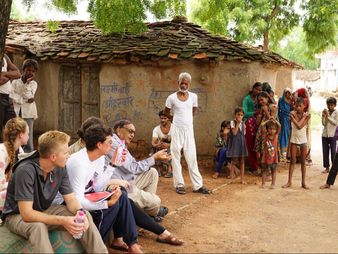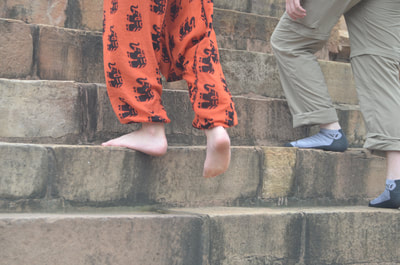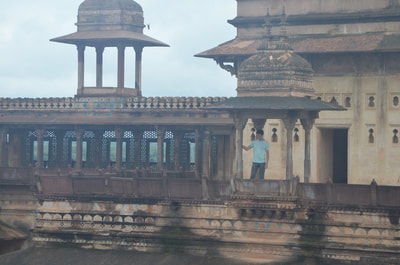Khajuraho, India

Religion and spirituality are an important part of life in India, especially in rural areas, where nearly 70% of the Indian population live. The caste system continues to be an important part of life in rural India, even though discrimination by caste is illegal by law. Therefore, before engaging the rural poor, students will spend time learning about religious practices in central India in a village called Khajuraho in the state of Madhya Pradesh about 400 miles southeast of Delhi. In 2011, it boasted a population of about 25,000 people, most of whom live on very meager incomes.
In northern India, most of the ancient religious sites from before the Mughal Period have been destroyed or repurposed into mosques or other buildings.
However, since Khajuraho was hidden in the middle of the jungle, many of their temples from the 12th century were preserved. Their ancient Hindu and Jain temples are preserved as UNESCO heritage sites. The area is particularly influenced by Jainism, which encourages a life lived by the principles “live and let live” and “do no harm to living things.” You can see this philosophy nearly everywhere in Khajuraho and the surrounding area. Water buffalo, cows, donkeys, goats, monkeys, and a menagerie of other animals wander the streets, sidewalks, and roadsides. It’s not unusual for a water buffalo and its calf to lay down in the middle of the main roadway and remain undisturbed by humans.
India has 22 official languages and as students travel from region to region, they have different guides and translators who are familiar with the local dialects. The guide in Khajuraho is affectionately known by villagers as Mamagi. Mamagi shows the students around two different historic sites where remarkable temple structures stand. Both sites are part of the UNESCO World Heritage Sites and are known as the Eastern and Western Groups of Temples. He also serves as the field guide and translator for the field visits to the first two groups of rural consumers.
In northern India, most of the ancient religious sites from before the Mughal Period have been destroyed or repurposed into mosques or other buildings.
However, since Khajuraho was hidden in the middle of the jungle, many of their temples from the 12th century were preserved. Their ancient Hindu and Jain temples are preserved as UNESCO heritage sites. The area is particularly influenced by Jainism, which encourages a life lived by the principles “live and let live” and “do no harm to living things.” You can see this philosophy nearly everywhere in Khajuraho and the surrounding area. Water buffalo, cows, donkeys, goats, monkeys, and a menagerie of other animals wander the streets, sidewalks, and roadsides. It’s not unusual for a water buffalo and its calf to lay down in the middle of the main roadway and remain undisturbed by humans.
India has 22 official languages and as students travel from region to region, they have different guides and translators who are familiar with the local dialects. The guide in Khajuraho is affectionately known by villagers as Mamagi. Mamagi shows the students around two different historic sites where remarkable temple structures stand. Both sites are part of the UNESCO World Heritage Sites and are known as the Eastern and Western Groups of Temples. He also serves as the field guide and translator for the field visits to the first two groups of rural consumers.
Orccha
|
Orccha is a historic town in the state of Madhya Pradesh. In 2017, students had the opportunity to stay a night in the city and explore Mughal palaces, temples, and cenotaphs.
There are daily classroom or field debriefing sessions during the trip. These are held in various locations depending on the availability of conference rooms in the hotels. In Orccha, students had a classroom session outside in the courtyard next to the historic buildings. Field VisitsIn Khajuraho, the students began field visits to study the six segments of rural and urban poverty. They visited a tribal village and a farming village.
|
Tribal Village: 1st Segment of Poverty |
Farming Village: 2nd Segment of Poverty |
















